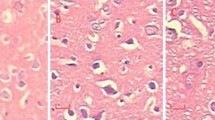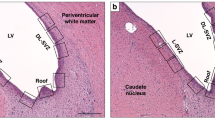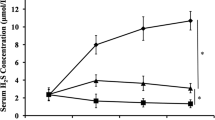Abstract
Objective
To investigate the expression of nerve growth factor (NGF) and glial cell line-derived neurotrophic factor (GDNF) in monkeys of resuscitation after selective cerebral ultraprofound hypothermia and blood flow occlusion.
Methods
The monkeys were immediately removed brain after death in operation of group A (identical temperature perfusion group) and group B (ultraprofound hypothermia perfusion group). Immunohistochemical technique was used to determine frontal cellular expression of NGF and GDNF. Statistics were analyzed by ANOVA analyses with significance level at P < 0.05.
Results
The expressions of NGF and GDNF in the group B were significantly higher than those in the group A (P < 0.05).
Conclusion
NGF and GDNF increased significantly in the monkeys of resuscitation after selective cerebral ultraprofound hypothermia and blood flow occlusion. It may be a protective mechanism for neuron survival and neural function recovery.
摘要
目的
观察常温缺血10 min后选择性超深低温断血流复苏后猴脑中神经生长因子(nerve growth factor, NGF)和胶质细胞源性神经营养因子(glial cell line-derived neurotrophicfactor, GDNF)表达的变化。
方法
等温组及超深低温组实验猴于灌注或复苏死亡后立即开颅取脑, 用NGF和GDNF抗体进行免疫组化染色;对额叶恒定视野内NGF和GDNF 的阳性细胞记数求阳性率, 并统计学分析。
结果
等温组2 只实验猴额叶NGF 和GDNF 有微量表达, 超深低温组4 只实验猴额叶NGF 和GDNF 表达明显上调, 与等温组比较差异均极显著(P < 0.01)。
结论
猴脑选择性超深低温断血流复苏实验可引起NGF和GDNF表达上调, 这可能是防止脑缺血的重要保护机制之一。
Similar content being viewed by others
References
Ohta T, Sakaguchi I, Dong LW, Nagasawa S, Yasuda A. Selective cooling of brain using profound hemodilution in dogs. Neurosurgery 1992, 31: 1049–1055.
Price TJ, Louria MD, Candelario-Soto D, Dussor GO, Jeske NA, Patwardhan AM, et al. Treatment of trigeminal ganglion neurons in vitro with NGF, GDNF or BDNF: effects on neuronal survival, neurochemical properties and TRPV1-mediated neuropeptide secretion. BMC Neurosci 2005, 6: 4–18.
Petruska JC, Mendell LM. The many functions of nerve growth factor: multiple actions on nociceptors. Neurosci Lett 2004, 361: 168–171.
Jiang JY, Xu W, Yang PF, Gao GY, Gao YG, Liang YM, et al. Marked protection by selective cerebral profound hypothermia after complete cerebral ischemia in primates. J Neurotrauma 2006, 23: 1847–1856.
Caba M, Bao J, Pau KY, Spies HG. Molecular activation of noradrenergic neurons in the rabbit brainstem after coitus. Brain Res Mol Brain Res 2000, 77: 222–231.
Whitlon DS, Szakaly R, Greiner MA. Cryoembedding and sectioning of cochleas for immunocytochemistry and in situ hybridization. Brain Res Brain Res Protoc 2001, 6: 159–166.
Yang XD, Liu Z, Liu HX, Wang LH, Ma CH, Li ZZ. Regulatory effect of nerve growth factor on release of substance P in cultured dorsal root ganglion neurons of rat. Neurosci Bull 2007, 23: 215–220.
Su YR, Wang J, Wu JJ, Chen Y, Jiang YP. Overexpression of lentivirus-mediated glial cell line-derived neurotrophic factor in bone marrow stromal cells and its neuroprotection for the PC12 cells damaged by lactacystin. Neurosci Bull 2007, 23: 67–74.
Chen KS, Nishimura MC, Armanini MP, Crowley C, Spencer SD, Phillips HS. Disruption of a single allele of the nerve growth factor gene results in atrophy of basal forebrain cholinergic neurons and memory deficits. J Neurosci 1997, 17: 7288–7296.
Nicholson DW, Ali A, Thornberry NA, Vaillancourt JP, Ding CK, Gallant M, et al. Identification and inhibition of the ICE/CED-3 protease necessary for mammalian apoptosis. Nature 1995, 376: 37–43.
Eldadah BA, Faden AI. Caspase pathways, neuronal apoptosis, and CNS injury. J Neurotrauma 2000, 17: 811–829.
Gurney ME, Tomasselli AG, Heinrikson RL. Neurobiology. Stay the executioner’s hand. Science 2000, 288: 283–284.
Armstrong RC, Aja TJ, Hoang KD, Gaur S, Bai X, Alnemri ES, et al. Activation of the CED3/ICE-related protease CPP32 in cerebellar granule neurons undergoing apoptosis but not necrosis. J Neurosci 1997, 17: 553–562.
Yanamoto H, Mizuta I, Nagata I, Xue J, Zhang Z, Kikuchi H. Infarct tolerance accompanied enhanced BDNF-like immunoreactivity in neuronal nuclei. Brain Res 2000, 877: 331–344.
Ramer MS, Priestley JV, McMahon SB. Functional regeneration of seneory axons into the adult spinal cord. Nature 2000, 403: 312–316.
Lehmann M, Fournier A, Selles-Navarro I, Dergham P, Sebok A, Leclerc N, et al. Inactivation of Rho signaling pathway promotes CNS axon regeneration. J Neurosci 1999, 19: 7537–7547.
Igari T, Hoshino S, Iwaya F, Ando S. Cerebral blood flow and oxygen metabolism during cardiopulmonary bypass with moderate hypothermic selective cerebral perfusion. Cardiovasc Surg 1999, 7: 106–111.
Ding Y, Li J, Luan X, Ding YH, Lai Q, Rafols JA, et al. Exercise pre-conditioning reduces brain damage in ischemic rats that may be associated with regional angiogenesis and cellular overexpression of neurotrophin. Neuroscience 2004, 124: 583–591.
Truettner J, Busto R, Zhao W, Ginsberg MD, Pérez-Pinzón MA. Effect of ischemic precond-itioning on the expression of putative neuroprotective genes in the rat brain. Brain Res Mol Brain Res 2002, 103: 106–115.
Li QY, Cheng GY, Pu PY, Zhang RZ, Lian H, Jiang DH. Changes of GDNF mRNA expression in rat brain following cerebral ischemia reperfusion. Chin J Neurosci 1999, 15: 243–246.
Author information
Authors and Affiliations
Corresponding author
Rights and permissions
About this article
Cite this article
Huang, XC., Xu, W. & Jiang, JY. Effect of resuscitation after selective cerebral ultraprofound hypothermia on expressions of nerve growth factor and glial cell line-derived neurotrophic factor in the brain of monkey. Neurosci. Bull. 24, 150–154 (2008). https://doi.org/10.1007/s12264-008-1702-1
Received:
Published:
Issue Date:
DOI: https://doi.org/10.1007/s12264-008-1702-1
Keywords
- nerve growth factor
- glial cell line-derived neurotrophicfactor
- ultraprofound hypothermic circulatory arrest
- resuscitation
- monkey brain




